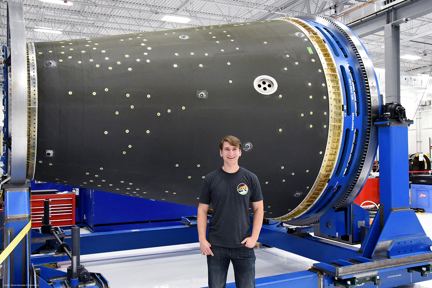Employee Spotlight: Meet Dream Chaser® Spaceplane Structural Engineer Chris B.
May 15, 2020

We sat down with Chris B., a member of Sierra Nevada Corporation’s (SNC) Dream Chaser® spaceplane team to find out how a newspaper led to his dream space job. Here’s more on how Chris saw an ad in The Denver Post that helped jumpstart his SNC career and why he says his job is a little like playing with Legos.
What drew you to working at SNC?
It was actually an advertisement in The Denver Post. The ad was for a career fair concerning NASA’s Commercial Crew Program contract that SNC was bidding for. After attending and speaking with a few people on the team, I was sold and wanted in! Thankfully, the feeling was mutual. I think Dream Chaser is the most interesting and versatile vehicle currently in development and I wanted to support that.
You’re a structural engineer; what’s a day in the life like?
As a structural engineer with SNC, I generally work in a computer aided design (CAD) program called NX, designing new parts for the vehicle. I love the pure creativity and imagination used to solve a problem. It’s like Legos, but I get to make the Legos out of metal and composites and then figure out how they go together.
Another aspect of the job is coordinating a team of people around the design requirements including materials, interface controls, stress, thermal, manufacturing and ultimately satisfying our customer’s needs. Specifically, I have been responsible for certain components that make up our Shooting Star transport vehicle, like the composite dome and the hatch adapter plate, which helps Dream Chaser berth to the space station.
What has been the most rewarding part of working on Dream Chaser so far?
The most rewarding aspect so far was when I saw the hatch adapter plate I designed fully machined and installed into Shooting Star. It is the largest metallic component on the vehicle at nearly 90 inches in diameter and took nearly two years to create, from beginning a clean slate design to its final installation.
I was given a tremendous amount of responsibility and got to spearhead a lot of processes and develop tools through the design progression that are still used today. I can’t wait to see the space station crew members welcome Dream Chaser and interact with my components!

Dream Chaser leadership says you’ve been doing some great work with the liaison team assisting the vehicle’s build. Can you explain what that entails?
The team here is doing outstanding work and I’m proud to be a small part of keeping the work going! I am currently involved with the liaison team, which supports the manufacturing production floor. The team is tasked with being a first line of defense in responding to questions or conditions which don’t meet requirements during assembly, test or integration.
We coordinate the affected parties when something doesn’t go quite as planned to organize a solution and, being a multi-skilled team, we can often solve many problems ourselves to reduce the interruptions as much as possible. It’s a fun, fast-paced side of engineering!
Why is space exploration so important to you?
Engineering in general is important to me; it’s all about learning and solving problems in new and ingenious ways. Space exploration has some of the most difficult problems to solve of any industry with zero margin for error, and with that, has infinite opportunities for innovative solutions.
I grew up with a father who designed the Mars Pathfinder camera, worked satellite programs and the Orion spacecraft, so I’ve always had a love for the field and appreciation for the complexity of the problems. When the opportunity presented itself to join the SNC team, I eagerly pursued it and have loved every day here.
---
Interested in joining the Sierra Nevada Corporation team? Apply today at sncorp.com/careers.